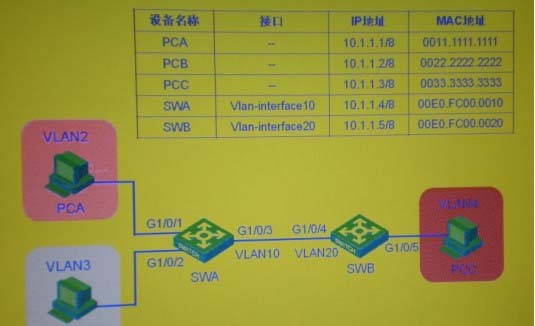- All Exams Instant Download
In the switching network as shown in the figure, VLAN10 is set as Isolate-user-vlan on switch SWA, VLAN2 and VLAN3 are set as Secondary VLAN of VLAN 10; VLAN2-VLAN20 is created on switch SWB, and VLAN20 is set as Isolate-user-vlan , VLAN4 is the Secondary VLAN of VLAN20. After setting the IP address of each device as shown in the figure, the following statement is correct (choose one or more)
In the switching network as shown in the figure, VLAN10 is set as Isolate-user-vlan on switch SWA, VLAN2 and VLAN3 are set as Secondary VLAN of VLAN 10; VLAN2-VLAN20 is created on switch SWB, and VLAN20 is set as Isolate-user-vlan , VLAN4 is the Secondary VLAN of VLAN20. After setting the IP address of each device as shown in the figure, the following statement is correct (choose one or more)

A . The packet of PCA enters from the GigabitEther1/0/1 port of SWA, and does not carry the VLAN tag after exiting from the GigabitEther1/0/3 port
B . The PCA packet comes out of the GigabitEthem1/0/3 port of SWA and enters the GigabitEthe1/0/3 port of SWB, and the VLAN Tag carried is VLAN2
C . When SWB accesses PCA, the VLAN tag carried by GigabitEthem1/0/4 of SWB is VLAN 1
D . SWB packets enter from SWA’s GigabitEthem1/0/3 port, and after exiting from GigabitEthem1/0/1 port, the VLANTag carried is VLAN2
Answer: A
Latest GB0-371-ENU Dumps Valid Version with 341 Q&As
Latest And Valid Q&A | Instant Download | Once Fail, Full Refund
Subscribe
Login
0 Comments
Inline Feedbacks
View all comments

